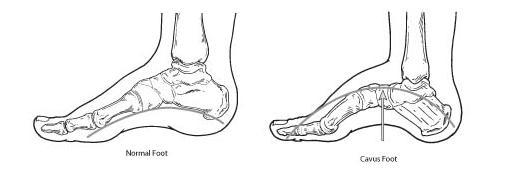Pes Cavus: Difference between revisions
No edit summary |
Wendy Walker (talk | contribs) No edit summary |
||
| Line 50: | Line 50: | ||
= References = | = References = | ||
'''<references />''' | '''<references />''' | ||
[[Category:Foot]] | |||
Revision as of 02:06, 18 March 2017
Original Editor - Sem Bras
Top Contributors - Esraa Mohamed Abdullzaher, Yasmina Hossam, Mathias Plas, Saeed Dokhnan, Uchechukwu Chukwuemeka, Kim Jackson, Wendy Walker, George Prudden, Rucha Gadgil, Habibu Salisu Badamasi, Admin and Sem Bras
Definition[edit | edit source]
Pes cavus is a foot with an abnormally high plantar longitudinal arche. People who have this condition will place too much weight and stress on the ball and heel of the foot while standing and/or walking .
Etiology[edit | edit source]
The etiology can be attributed to the brain, spinal cord, peripheral nerves, or structural problems of the foot. When motor imbalance begins before maturation of the skeleton, there can be a substantial change in healthy bone morphology. When cavus is acquired after skeletal maturity, there may be little or no change in the morphology. Two thirds of adults with symptomatic cavus foot have an underlying neurologic condition, most commonly : Charcot-Marie-Tooth (CMT) disease.
Pes cavus types[edit | edit source]
It is classified into two major types : Congenital and Idiopathic .[1]
Clinically relevant Anatomy[edit | edit source]
Clinically it is an abnormal elevation of the medial arch in weight bearing. Biomechanically, cavus is defined as a varus hindfoot, high calcaneal pitch, high-pitched midfoot and plantarflexed and adducted forefoot.
When the angle between the talus and calcaneus is narrowed, the os naviculare moves to a superior position to the cuboid, instead of medial to it. This makes it difficult for the Chopart-joint to function.
The talus is the connector of the foot and the ankle. In a neutral foot, the foot rotates around the talus and the cuboid follows the calcaneus.
Characteristics[edit | edit source]
During the gait cycle, the foot remains locked in hindfoot inversion and forefoot varus throughout the stance phase, causing less stress dissipation. This can result in metatarsalgia, stress fracture of the fifth metatarsal, plantar fasciitis, medial longitudinal arch pain, ilio-tibial band syndrome and instability. This locking and unlocking of the Chopart-joint is a critical element in the cavus-foot.
In an cavus foot, the calcaneus is rotated internally beneath the talus, resulting in an narrow anterior-posterior talo-calcaneal angle. Since the cuboid follows the calcaneus, the cuboid is plantar to the navicular, instead of beside it. This locks the midfoot and overloads the lateral side of the foot .
Another way to look at he chopart function is to view the foot from the front with the forefoot removed . If an axis, drawn through the two joints, is parallel to the ground, there will be relatively free flexion. The more the axis approaches a vertical orientation, the less flexion will be possible.In extremely high-arched feet, the weight bearing is distributed unevenly along the metatarsal heads and the lateral border of the feet. This type of disorder causes the foot to prone to metatarsal head and calcaneal contusions, caused by the excessive pressure of weight bearing. Also the foot is prone to osteophyte formation at the junction of the metatarsal bases and the cuneiforms.
Symptoms and clinical presentation[edit | edit source]
Patients complain pain , instability , difficulty walking and problems with footwear .
The symptoms vary with the degree of deformity .[2]
Medical management[edit | edit source]
Medical management is to allow the patient to ambulate without any problems. It is important the patient to understand that surgical reconstruction does not provide a normal foot. The main goal of surgical reconstruction is to produce a plantigrade foot and pain relief. Repeated surgical procedures can be necessary, especially if the deformity is progressive. Surgical procedures can be broadly categorized into soft-tissue and bony procedures. Tendon transfers and osteotomies can provide correction of the deformity without requiring an arthrodesis.
Physiotherapy managment [edit | edit source]
Suggested conservative management of patients with painful pes cavus typically involves strategies to reduce and redistribute plantar pressure loading, with use of foot orthoses and specialized cushioned footwear. The orthoses for pes cavus needs to accomplish to several specific goals:
• Increasing plantar surface contact area
The overload on the metatarsal heads is a result of limited plantar surface contact due to high arch and limited ankle-joint dorsiflexion. Increasing the plantar surface contact ensures the foot to bear more weight in the arch while the metatarsal heads bear less weight during activity.
• Resisting against excessive supination
Lateral ankle stability and laterally deviated subtalar joint axis (STJ) are frequently associated with high-arched feet. This position results in an excessive supinator torque around the subtalar joint axis.
• Resisting against recessive pronation and supination forces
Rearfoot instability is caused by an extension of the laterally deviated subtalar axis. In flexible pes cavus, midtarsal flexibility complicates the later portion of the stance pgase of gait. The forefoot pathology produces midtarsal joint supination, that leads to excessive pronation of the rearfoot. Some pes cavus suffer from both lateral ankle instability at midstance and rearfoot pronation at late midstance.







